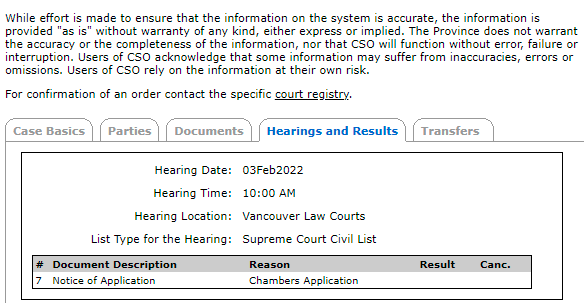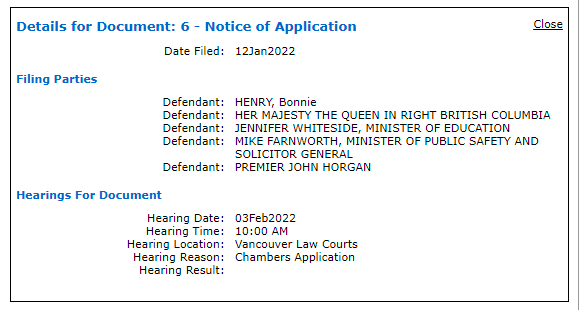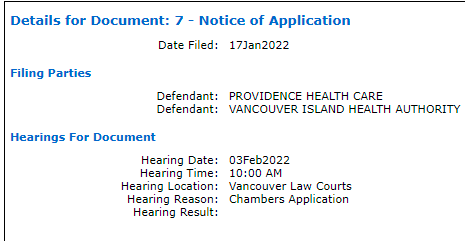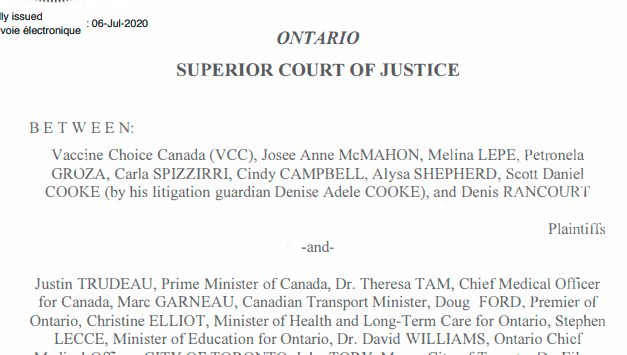





Action4Canada and other Plaintiffs were supposed to be in Court on February 3rd, in order to address 2 Applications (here and here) filed back in January. But due to an extremely convenient medical illness, this has been pushed back until April 5th. It’s unclear why Lawrence Wong didn’t simply step up, as he’s been a B.C. lawyer since 1987.
Private matters generally aren’t worth covering. However, their August 2021 lawsuit is a very public case, and has involved soliciting public donations since 2020. It’s fair that people know its true status: that it’s on the verge of being struck.
For all the money that was sunk into getting this lawsuit off the ground, it never stood a chance.
It feels odd to have a previous piece age so well. Back in August 2021, this site critiqued the 391 page lawsuit filed by Action4Canada in Vancouver. The basic premise was that the Notice of Civil Claim was drafted so poorly, it didn’t stand a chance in hell of making it to trial.
To be more specific, the Notice of Claim didn’t follow (at all) Rules 3-1, and 3-7 of BC Civil Procedure. These outline how pleadings are to be drafted. The logical remedy — from the Defendants’ position — would be to file a Motion or Application to strike based on Rule 9-5. This rule allows cases to be struck for a number of reasons, including for being “frivolous, vexatious, or an abuse of process”. Pleadings can also be struck if they don’t disclose a reasonable cause of action.
To make a distinction here: dismissing and striking are not the same thing. Dismissing a case usually means a Judge has made a determination about the merits of the case. By contrast, striking means attacking the pleadings themselves.
For those wondering what “struck without leave to amend” means, here’s an explanation. Sometimes, the Court will “give leave” or permission, to make changes to the pleadings (allowing content to be added or deleted). This is typically meant for very minor issues. For serious problems, such as with this lawsuit, the defects are so extensive that the Court won’t allow it.
Anyone with a rudimentary understanding of civil procedure would have looked at Action4Canada’s case and saw where this was going.
Now the other shoe has dropped, and at least 2 Applications have been filed. The first is from the various Provincial Defendants, and the other from Vancouver Island Health Authority and Providence Health Care. They are trying to strike the case for essentially the same reasons outlined on this site back in August, 2021.
To state the obvious: this doesn’t mean supporting or advocating for the medical martial law measures that have gone on in the last 2 years.
Nonetheless, it’s pretty difficult to argue with the premise of the Application. Specifically, Defendants are trying to get the case struck as being “frivolous, scandalous, vexatious, prolix, and an abuse of process”. This isn’t just written in a shoddy manner, but it’s over-the-top ridiculous.
The Claim contains many pages of completely irrelevant material, seeks remedies outside the Court’s jurisdiction, and makes allegations against people who aren’t parties (and presumably haven’t been subpoenaed). It’s also extremely disjointed and difficult to follow along with.
It’s hard to believe that 2 very senior, very experienced lawyers could draft this garbage. Combined, they have nearly 70 years of legal work completed. While the Claim does contain a fair amount of truthful information, it’s written so badly that no Judge will ever consider it.
By contrast, the Notices of Application were extremely well written, to the point, and raised many fatal defects in the Notice of Civil Claim. Again, this isn’t to defend the Horgan/Henry regime, but their lawyers make a compelling case as to why this should be thrown out. Although there are 2 Applications, the content is very similar.
3. The Claim is a prolix and convoluted document that is replete with groundless accusations against public officials, inflammatory language, and conspiracy theories.
6. The Plaintiffs’ Claim is deficient in form and substance. It is a scandalous, frivolous, and vexatious pleading that fails to meet the basic requirements for pleadings and is an abuse of the Court’s process. The Claim should be struck in accordance with Rule 9-5(1) of the Supreme Court Civil Rules, without leave to amend.
Pleadings Generally
7. Supreme Court Civil Rule (the “Rules”) 3-1 provides, in part:
Contents of notice of civil claim
(2) A notice of civil claim must do the following:
(a) set out a concise statement of the material facts giving rise to the claim;
(b) set out the relief sought by the Plaintiff against each named defendant;
(c) set out a concise summary of the legal basis for the relief sought;
…
(g) otherwise comply with Rule 3-7. [emphasis added]
8. Rule 3-7 provides, in part:
Pleading must not contain evidence
(1) A pleading must not contain the evidence by which the facts alleged in it are to be proved.
…
Pleading conclusions of law
(9) Conclusions of law must not be pleaded unless the material facts supporting them are pleaded.
…
General damages must not be pleaded
(14) If general damages are claimed, the amount of the general damages claimed must not be stated in any pleading. …
9. The function of pleadings is to clearly define the issues of fact and law to be determined by the court. The plaintiff must state, for each cause of action, the material facts. Material facts are those facts necessary for the purpose of formulating the cause of action. The defendant then sees the case to be met and may respond to the plaintiff’s allegations in such a way that the court will understand from the pleadings what issues of fact and law it will be called upon to decide.
.
Homalco Indian Band v. British Columbia, [1998] B.C.J. No. 2703 (S.C.), para. 5
10. As the Court of Appeal recently held in Mercantile Office Systems Private Ltd. v. Worldwide Warranty Life Services Inc., 2021 BCCA 362, para 44:
None of a notice of claim, a response to civil claim, and a counterclaim is a story. Each pleading contemplates and requires a reasonably disciplined exercise that is governed, in many instances in mandatory terms, by the Rules and the relevant authorities. Each requires the drafting party to “concisely” set out the “material facts” that give rise to the claim or that relate to the matters raised by the claim.
None of these pleadings are permitted to contain evidence or argument.
Application to Strike
11. Rule 9-5(1) provides:
Scandalous, frivolous or vexatious matters
(1) At any stage of a proceeding, the court may order to be struck out or amended the whole or any part of a pleading, petition or other document on the ground that
(a) it discloses no reasonable claim or defence, as the case may be,
(b) it is unnecessary, scandalous, frivolous or vexatious,
…
(d) it is otherwise an abuse of the process of the court …
12. A pleading may be struck under Rule 9-5(1) if it is plain and obvious that the pleading contravenes any of Rule 9-5(l)(a) through (d).
.
Knight V. Imperial Tobacco Canada Ltd, 2011 SCC 42 at para. 17
Rule – 9-5(l)(a)-The Notice of Civil Claim Discloses No Reasonable Claim
14. The Claim is premised upon non-justiciable questions and relies heavily upon international treaties, Criminal Code provisions, and unknown causes of action that are incapable of disclosing a reasonable cause of action for the purposes of Rule 9-5(1)(a).
16. The Plaintiffs allege numerous violations (and non-violations) of the Criminal Code that are not properly raised in a civil action (Simon v. Canada, 2015 BCSC 924, para. 45); including:
17. The Plaintiffs allege numerous violations of international legal instruments, unwritten constitutional principles, and causes of action unknown to law that are not actionable in Canadian courts (Li v. British Columbia, 2021 BCCA 256, paras. 107-109; Toronto v. Ontario, 2021 SCC 34, para. 5), including the following:
19. The general rule that facts pleaded should be accepted as true for the purposes of a strike application does not apply in a “case like this where the notice of civil claim is replete with assumptions, speculation, and in some instances, outrageous allegations. The law is clear that allegations based on assumption and speculation need not be taken as true.”
.
Willow v. Chong, 2013 BCSC 1083, para. 19
See, also, Simon v. Canada, 2015 BCSC 924 [“Simon”], para. 54
20. The Plaintiffs have failed to plead the concise statement of material facts that is necessary to support any complete cause of action. The Charter claims are inextricably bound up in a prolix, argumentative, and wildly speculative narrative of grand conspiracy that is incapable of supporting a viable cause of action. It is impossible to separate the material from the immaterial, the fabric of one potential cause of action or claim from another, or conjecture and conspiracy from asserted facts.
.
Fowler v. Canada (Attorney General), 2012 BCSC 367, para. 54
Simon, supra, paras 54-59
9-5(l)(b) The Notice of Civil Claim is Scandalous, Frivolous and Vexatious
Scandalous and Embarrassing
22. A pleading is scandalous if it does not state the real issue in an intelligible form and would require the parties to undertake useless expense to litigate matters irrelevant to the claim.
.
Gill v. Canada, 2013 BCSC 1703 [“Gill”], para. 9
23. A claim is also scandalous or embarrassing if it is prolix, includes irrelevant facts, argument or evidence, such that it is nearly impossible for the defendant to reply to the pleading and know the case to meet. Pleadings that are so prolix and confusing that it is difficult, if not impossible, to understand the case to be met, should be struck.
.
Gill, supra para. 9
Strata Plan LMS3259 v. Sze Hang Holding Inc., 2009 BCSC 473, at para. 36
Kuhn v. American Credit Indemnity Co., [1992] B.C.J. No. 953 (S.C.)
24. The Claim is a scandalous pleading because it is prolix, confusing, and nearly impossible to respond to:
a. The 391 page Claim attempts to plead dozens of causes of action and Charter breaches and seeks over 200 declarations. It is, as a result, nearly impossible to know the case to be met.
b. The Claim contains extensive passages of completely irrelevant information, including:
Rule 9-5(l)(a) and (d) – The Claim is Vexatious and an Abuse of Process
28. Little distinction exists between a vexatious action and one that is an abuse of process as the two concepts have strikingly similar features.
.
Dixon v. Stork Craft Mamifacturing Inc., 2013 BCSC 1117
29. Abuse of process is not limited to cases where a claim or an issue has already been decided in other litigation, but is a flexible doctrine applied by the court to values fundamental to the court system. In Toronto (City) v. Canadian Union of Public Employees, Local 79 (CUPE), [2003] 3 S.C.R. 77, the court stated at para. 37:
.
Canadian courts have applied the doctrine of abuse of process to preclude relitigation in circumstances where the strict requirements of issue estoppel (typically the privity/mutuality requirements) are not met, but where allowing the litigation to proceed would nonetheless violate such principles as judicial economy, consistency, finality and the integrity of the administration of justice.
30. Vexatious actions include those brought for an improper purpose, including the harassment and oppression of other parties by multifarious proceedings brought for purposes other than the assertion of legitimate rights. Where it is obvious that an action cannot succeed, or if the action would lead to no possible good, or if no reasonable person can reasonably expect to obtain relief, the action is vexatious.
.
Lang Michener Lash Johnston v. Fabian, [1987] O.J. No. 355 [“Lang Michener”], at para. 19
33. The Applicants submit the Claim has been brought for an improper purpose. The Plaintiffs and their counsel must know, or ought to know, that a 391 page Claim seeking over 200 declarations concerning alleged criminal conduct and the efficacy of public health measures “cannot succeed … [and] would lead to no possible good”: Lang Michener, supra.
34. The Claim is intended, at least in part, to intimidate and harass health authorities, public officials and politicians, including the Provincial Health Officer, by advancing spurious, public allegations of criminal conduct, conflicts of interest, and ulterior motives. This intention is further corroborated by the Plaintiff Action4Canada’s simultaneous campaign to encourage individuals to serve government officials and politicians with “Notices of Liability” for their actions in responding to the COVID-19 pandemic (Affidavit #1 of Rebecca Hill, Ex. G, I).
35. The Claim is also intended, at least in part, to consolidate, publicize, and amplify COVID-19 conspiracy theories and misinformation. The Claim is a book-length tirade against the entirety of British Columbia’s response to the pandemic, with dozens of quotes from, and hundreds of footnotes to, anti-mask, anti-lockdown, and anti-vaccine resources. Both Action4Canada and its counsel have promoted the Claim online and on social media
.
(Affidavit #1 of Rebecca Hill, Ex. D, K).
36. These are improper purposes to file and prosecute a civil action. There can be no question that the Claim is an abuse of process. Permitting this litigation to proceed would violate the principles of judicial economy and the integrity of the administration of justice.
The above quotes came from the January 17 Notice of Application. Re-read the original Notice of Civil Claim and ask: what are they wrong about?
The Applications get into allegations that Action4Canada is causing harassment of Government Officials as a result of their behaviour. This is where things get more interesting:

This Application also contains an Affidavit from Rebecca Hill. She apparently works for Mark Witten, the lawyer for the B.C Defendants. She’s alleging that the “Notices of Liability” that Action4Canada provides have led to the bombardment of Government Officials. From the information provided, it’s strongly implied that this is done in order to drive up the donations.
By extension, it wouldn’t take much to argue that the entire Notice of Claim was a stunt to get more people handing out money.
Remember those notices you downloaded, filled out, and submitted? Guess what? Many of them, and the emails, are now saved as evidence by the B.C. Government.
Author’s note: since the Vancouver Court has apparently not scanned the entire Affidavit, the attachments are not available. That may be for the best, as there is contact information.
It’s also worth pointing out: the Defendants are asking for costs as well. This is pretty much inevitable, once the case is thrown out. It seems unlikely that any Plaintiff has given this serious thought. For a reference point, Adam Skelly was hit with a $15,000 cost award, just for trying to open his restaurant. Given the size and vexatious nature of the Action4Canada case, it’s quite possible for everyone to be on the hook for several thousand dollars each. Keep in mind, court costs aren’t dischargeable in bankruptcy.
Once more, this isn’t an attempt to defend the B.C. Government. That said, the Claim was written in such a convoluted way, it never stood a chance. One has to ask why it really happened.
Back in October, Action4Canada posted a reply to the response they received from the B.C. Government. It’s amusing that they act indignant that Rule 9-5 was quoted verbatim. Spoiler: if you want a Court to toss a case, you have to cite the law that allows it.
Whether this case is decided on April 5, or is set back again, the ultimate result is the same. Once a Judge sits down with the lawsuit, it’s getting struck without leave to amend.

It’s not just the B.C. case that will be struck. The Ontario ones will be soon as well. Many will remember this filing from July 6, 2020. More than a year and a half later, there are still no defenses filed, no motions, no applications, no scheduled appearances.
In fact, under Rules 14 and 24 of civil procedure in Ontario, all of these idling cases could probably be dismissed at any time for unnecessary delay.
One other thing to consider is the Statute of Limitations. For most things in Ontario and B.C., a person has 2 years to commence legal action. Now, if a case is filed, but sits for years and is simply dismissed, it may be too late to start another. This doesn’t stop the clock. Something to think about.
Prediction: once the B.C. case is struck (for the reasons listed above), the Ford regime will then make similar Applications for the Ontario cases.
Other than wasting a lot of time and money, what has this actually accomplished?
COURT DOCUMENTS
(1) A4C Notice of Civil Claim
(2) A4C Response October 14
(3) A4C Legal Action Update, October 14th 2021 Action4Canada
(4) A4C Notice of Application January 12
(5) A4C Notice of Application January 17
(6) A4C Affidavit
(7) A4C Response VIH-Providence January 17
(8) A4C Response to Application BC Ferries January 19
